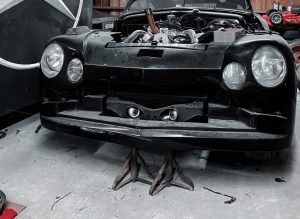April 26, 2022
8 Steps to Safely Lift and Support Your Vehicle Using a Car Jack Stand

Photo by Style Stance under Pexels License
While you can use a car jack to change a tire, jack stands help keep you safer when working under your car. In this guide, you’ll learn how to pick the right spot to lift your vehicle, set up your jack and stands safely, and check that everything is secure before you start working. Follow these simple steps, and you’ll know how to do the job right and stay safe.
You need to be very careful when using a car jack and jack stands. It can be confusing if this is your first time. Lifting your car in the wrong spot can damage parts and might hurt you.
So, how do you use a car jack and stands the right way? What should you do and avoid to keep everything safe and secure? Veteran Car Donations tells you everything you need to know:
- Park on a flat, level surface.
Jacks and jack stands only work by lifting straight up. Gravity holds your car down on flat ground. But if your car is on a slope, it can slip off the jack or stand.
The best place to jack your car is in a garage or on a flat driveway. Don’t use bumpy spots, gravel, or busy areas. Make sure both sides of your car are level so the jack or stands don’t slip.
- Read the owner’s manual.
Every car has certain spots for jacking, like frame or suspension points. Before you start, check your car’s manual and the instructions for your jack and stands. Follow their weight limits and safety tips. Your jack and stands should hold at least half your car’s weight.
- Assemble your lifting and supporting gear.
You might only need to lift one wheel, one end, or the whole car. If you lift one end, use two jack stands. For the whole car, use four. If you are on soft ground like grass or asphalt, put thick plywood under the stands so they don’t sink.
- Chock the wheels.
Put your car in park or gear. Then, block the wheel on the opposite side of where you lift. Use two chocks — one in front and one behind the wheel — to stop your car from moving. You can use metal, wood, plastic, or rubber chocks.
- Raise your car.
Now you can lift your car. Pick a solid jacking point that leaves space for the jack stand. If you lift one wheel, just raise that corner. For the whole front or back, use a jack point on the frame near the suspension.
- Support your car.
After you lift your car, set up the jack stands. If you support one corner, place the stand under the jacking point. Raise it to the right height and lock it with the pin or pawl.
If you support the whole front or back, use two jack stands. Try to set them at the same height and lock them. Slowly lower the jack so the car’s weight rests on the stands.
If you lift the whole car, start with the front. Raise it as high as your jack and stands allow. Then, move to the back with the second pair of stands.
- Check each jack stand.
Check if all the stands hold your car steady. If you feel any wobble, lift that corner again. Move the stand up a little and lock it again.
- Shake your vehicle.
To make sure your car is safe, give it a gentle shake. The stands should stay flat and steady without any movement. When it passes this test, you can safely work on your car.
Got Questions? Here Are Answers to Help You Use Your Car Jack and Jack Stands Safely
Now that you know the basic steps for safely lifting and supporting your vehicle, you might still have some questions.
What Types of Jack Stands Are Safest?
The safest jack stands are those made from high-grade steel or aluminum and rated for more weight than your vehicle. Look for ANSI or ASME certified models with wide bases for added stability. Whether you’re working on a van, pickup truck, or SUV, make sure the stand’s height range can accommodate higher lift points. Always match the jack stand’s capacity to your vehicle’s weight and type.
What Problems Can Happen With Jack Stand Materials?
Low-quality materials like thin or poorly welded metal can crack or buckle under load. Rust, corrosion, or fatigue in the welds also increase the risk of failure. This is especially important for heavier vehicles like vans, pickup trucks, and SUVs, which require more durable support. Always inspect stands for visible signs of damage or wear before every use.
How Often Should You Check or Replace Jack Stands?
You should inspect your jack stands before each use for rust, cracks, bent parts, or loose pins. Even high-quality stands can wear out over time, especially if stored outdoors. If you use them frequently for repair for your pickup truck or SUV, consider replacing them every few years or after any noticeable damage.
What Are the Dangers of Cheap or Unrated Jack Stands?
Cheap or unrated jack stands often lack quality control and fail under load, even if used correctly. This can lead to sudden collapse, causing severe injury or worse. Heavier vehicles like SUVs and pickup trucks demand stands built for their weight. Avoid any jack stand that doesn’t clearly show its weight capacity or meet recognized safety standards.
How Should You Position Yourself When Working Under a Car on Jack Stands?
Always lie in a position that allows for a quick escape route. Stay centered between the jack stands, never in line with tires or suspension components that could shift. This is especially important when working under larger vehicles like pickup trucks or SUVs, where the stakes are higher.
How Can You Tell If a Jack Stand Is About to Fail?
Warning signs include creaking sounds, wobbling, or visible cracks in the welds or frame. If the stand shifts when you apply pressure or doesn’t feel solid under your SUV or pickup truck, stop the repair immediately. Trust your instincts — if something feels off, resecure or replace the stand before continuing.
Does Weather Affect Jack Stand Safety?
Yes. Moisture can lead to rust or corrosion, weakening the structural integrity over time. Extreme cold can make cheap metals brittle. If you store jack stands in a garage or shed, be sure they stay dry and clean. This is especially important if you’re doing regular maintenance on a pickup truck or SUV outdoors.
What Should You Do If a Jack Stand Fails While You’re Under the Car?
If a jack stand fails while you’re under the vehicle, your best protection is preparation. Use wheel chocks, a backup jack, or keep another stand nearby for added safety. Never rely on a single jack or stand. For SUVs and pickup trucks especially, proper planning is your first defense against disaster.
Give Your Old Car a New and Worthy Purpose
Did you know your old car can help veterans and their families in your area? Just donate it to Veteran Car Donations, and you’ll make a difference.
We sell your vehicle at auction. Then, we use the money to support programs that improve veterans’ lives through our charity partners. These IRS-approved 501(c)(3) nonprofit organizations are dedicated to helping former U.S. service members who are homeless, unable to find employment, and suffering from disabilities and serious illnesses, including mental disorders.
Our charity partners use the funds to give veterans free medical care, therapy, financial help, family support, housing, scholarships, job opportunities, and more.
To return the favor, our team will pick up and tow your vehicle for free anywhere in the country. We’ll also promptly send you the 100% tax-deductible sales receipt of your car via mail soon after its sale. You can use the receipt to claim the highest possible tax deduction in the next tax season.
But the greatest reward is feeling good about helping the brave men and women who served our country.
We accept nearly all types of vehicles, including those that aren’t in their best shape anymore.
Want to learn more about our vehicle donation program? Go visit our FAQs page. If you have any questions for us, call us through our 24/7 toll-free hotline at 877-594-5822. You may also write to us here and we will get in touch with you as soon as we can.
Support Our Hurting Heroes Today!

Photo by RDNE Stock project under Pexels License
Your car donation will truly touch the lives of veterans nearby. It will make a real difference for them. Call Veteran Car Donations at 877-594-5822 or fill out our secure online donation form now!
Last Updated: July 1st, 2025
